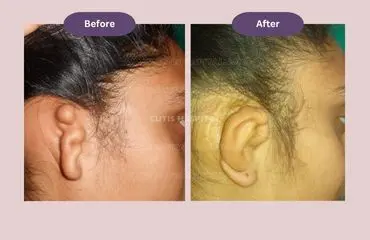Disfigured ears due to trauma, birth defect, or illness causes emotional and psychological distress. Insecurity of not being able to hear, or not appearing physically attractive is soul dampening for people. However, ear reconstruction surgery comes to rescue because it aims to recreate a proportionate shape and size to the ear. This delicate procedure requires deep knowledge of plastic surgery and ear care (otolaryngologist).
Ear reconstruction surgery is designed to aesthetically improve defects in either or both ears. It aims to rectify ear’s shape and appearance caused due to an injury, trauma, cancer removal, or microtia (malformed ears).
Each ear reconstruction process is tailored to meet the unique needs of patients. Thus, each reconstructive surgery employs different techniques that demands deep knowledge of internal and external ear physiology for an optimal cosmetic result.
Autologous reconstruction: This procedure is performed on children with defective ears present at birth. It uses rib cartilage to recreate ears. The surgery is done between ages 6 and 10 because the ears have attained their adult size, and sufficient rib cartilage is available.
Implants: This procedure uses medical implants designed for the ear framework. The surgeon mounts the implant at the site and covers it with skin extracted from the sides of the head or other body parts. A 3-year-old child can undergo this treatment.
Prosthetic reconstruction: This procedure is conducted on adults who have suffered ear deformities due to cancer surgery or burns. The complete ear is removed, and prosthesis (artificial ear) is surgically anchored into the bone at the site.
Ear reconstruction surgery involves a team of specialized physicians and plastic surgeons. If hearing loss is present, a hearing specialist (audiology doctor) will be involved in the surgical planning. The surgery is performed under general anesthesia. Usually, the rib cartilage is used to create the ear framework, but prosthetics and implants can also be used. The framework is mounted at the ear site, followed by covering it with skin extracted from the sides of the head or other body parts.
To analyze if you are a good candidate for ear reconstruction procedure, your doctor will review medical history, conduct physical, imaging exam/X-ray. Further, your doctor will explain the type of procedure you will be undergoing based on your profile and associated risks.
Depending on the surgery type, you may be required to stay in the hospital for a few days or sent back home the same day. Post-ear reconstruction surgery, you may experience pain, itching, swelling, or bleeding. Take medication as directed by your doctor, in case of severe pain immediately contact your healthcare practioner.
You may need to wear protective ear care covering for the wound to heal completely. Avoid placing pressure or rubbing your ear. Avoid sleeping on the ear reconstructed side. Wear loose-fitting collared shirts.
Ask your doctor about resuming work and strenuous activities. Your children need constant monitoring, as rough play can damage the ear reconstruction.
Lastly, follow-up care appointments are needed after the surgery.
Since ear reconstruction is a delicate and complicated process, it requires a team of specialists: a plastic surgeon, an otolaryngologist, and an audiology doctor. Our panel consists of all practitioners who use their deep knowledge and the latest technology to achieve superior outcomes. Our skilled surgeons focus on reconstructing natural-looking ears that complement facial features.


Ear reconstruction surgery is suitable for individuals who seek to correct a total or partial ear defect. Candidates for the surgery include:
Depending on the condition of your ears, health history, physical examination and X-rays, your team of doctors may either opt for either autologous, implants, or prosthetic reconstruction.
Our skilled surgeons aim at reconstructing natural-looking ears that perfectly match with your face. Based on their approach, you may require multiple procedures to achieve optimal outcome.
Although ear reconstruction surgery may not cause substantial discomfort, yet there could be mild pain, that can be treated with prescribed medication. It’s highly unlikely that this procedure may cause hearing loss or infection.
Ear reconstruction treatment may vary in intensity and scope due to the type of surgery chosen. Nonetheless, the procedure involves attaching the ear framework to the bone, covering the site with skin, and bandaging it to heal. If you require multiple procedures, they will be scheduled about 2-3 months apart.
Cutis Hospital is conveniently located in Ghatlodia, Ahmedabad, making it easily accessible via multiple modes of transportation. Below are the various ways you can reach our facility:
Sardar Vallabhbhai Patel International Airport: Located approximately 12.7 km from Cutis Hospital, offering convenient access for patients traveling from outside the city.
Chandlodiya Railway Station: Approximately 2.4 km from Cutis Hospital.
Ahmedabad Railway Station: Around 11 km from our center.
GSRTC:
Ahmedabad Central Bus Station (GSRTC): About 10.3 km from the hospital.
AMTS:
Bhuyangdev Cross Road Bus Stop: Just 500 meters from Cutis Hospital.
BRTS:
Bhuyangdev BRTS Bus Stop: Only 170 meters from our center.
We provide effective surgical and non-surgical treatments for all parts of the body. At Cutis Hospital, our cosmetic and plastic surgery team is committed to giving patients safe and high-quality care.